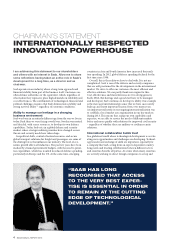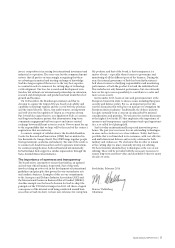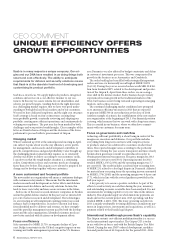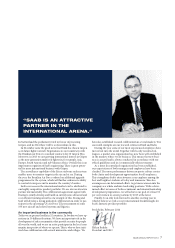Saab 2013 Annual Report Download - page 17
Download and view the complete annual report
Please find page 17 of the 2013 Saab annual report below. You can navigate through the pages in the report by either clicking on the pages listed below, or by using the keyword search tool below to find specific information within the annual report.
SAAB ANNUAL REPORT 2013 13
MIDDLE EAST AND AFRICA
The availability of reliable data on defence budgets in Africa is somewhat
awed, but the trends in defence spending in Africa suggest that these will
increase in coming years, particularly in Sub-Saharan Africa.
One of the challenges in the Middle East is to leave the dependence
on oil behind and to move towards a more sustainable industrial base.
The reduced focus on energy and the global interest in stability in the
region mean that there is a need to increase the national defence and
security capabilities. This means that expenditure is increasing in the
region. The growing ow in society implies strong performance in the
market for civil aviation and shipping.
According to IHS Jane’s Defence & Security Saudi Arabia increased its
defence and security budget by 18.6 per cent in 2013 and has the largest
defence budget in the region, accounting for 3 per cent of total global
defence spending in 2013.
Share of global defence spending in 2013 9%
ASIA AND PACIFIC REGION
In 2013, spending in the area accounted for 24 per cent of total global
defence spending. This entire region increases its defence spending by
3.3 per cent annually, and growth is primarily driven by China. China
and Japan are the two countries that had the largest defence budgets
in the region. IHS Jane’s Defence & Security estimates that in 2013
China accounted for 8.4 per cent of total global defence spending, and
shows an annual 11 per cent increase of defence spending. In 2013,
Japan’s total defence budget was the third largest in the world and ac-
counted for 4.3 per cent of total global defence spending.
The defence budget in India has seen nominal annual growth. How-
ever, its expenditure is impacted by deferred decisions and a weak-
ened local currency. The procurement process for defence materiel
means that co-operation and local manufacturing are favourable in
India. In addition to modernisation of the armed forces, increased
asymmetric threats have led to a need to also modernise the coast
guard, paramilitary organisations and civil security.
Share of global defence spending in 2013 24%
NATO
Many EU countries are members of NATO. In addition to NATO’s fun-
damental role to safeguard its members’ freedom and security through
economic and military means, the alliance also has a growing interest
in civil security and peacekeeping missions. These are often carried
out in co-operation with the EU and the UN. However, NATO has a
small joint budget and its missions are nanced by individual countries.
The ongoing restructuring of NATO and a change in focus, which
means the end of the long period of missions in Iraq and Afghanistan,
will pose new demands on NATO’s capabilities in Europe.
UNITED NATIONS, UN
The UN is the largest multilateral organisation in the world when it
comes to stabilising con icts and post-con ict situations. The growing
number of natural disasters also requires greater involvement of the
UN in the form of equipment and personnel. In 2012, UN procurement
was worth USD 15.4 billion, involving both peacekeeping operations
and humanitarian efforts.
The UN offers a stable and increasingly accessible market for players
such as Saab, which operates in the civil and military elds and in the
grey zone in between. Part of the UN’s peacekeeping work includes
delivering logistics solutions. Saab has developed a capability to
deliver this type of solution, even in highly complex environments, and
has since 2010 been engaged by the UN to operate a service centre
with maintenance, training, inventory management etc in East Africa. In
order to become a long-term supplier to the UN, Saab will focus on a
number of selected niches such as solutions for maintenance, systems
of unmanned craft and a number of pure product offerings.
Source: IHS Jane’s Aerospace, Defence & Security, Defence Budgets Annual Report 2013
























